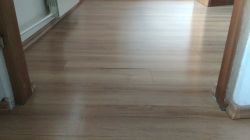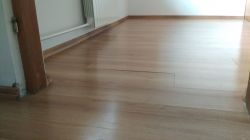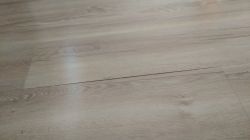As usual, the foreman knew better that the deviation of the unevenness of the floor before laying the panels could be more than 3 mm.
After about a year in the transition between rooms, unfortunately one panel collapsed and the pen broke. I don't care to disassemble the entire floor, especially since it has already been changed once.
I was thinking of letting in some low pressure foam to fill the empty space, but as soon as I take the tube / tubing out of the drilled hole it starts flowing out ... we could put some M8-M10 screw in. Then, however, there is a risk whether I will make it in time and whether the tightness will be maintained. After screwing in, the edges of the hole will surely rise and the decorative top coating will come off. A small "hole" will turn into a big one :)
Maybe extend the hose and try to let in somehow from the side of the frame ?? But it is about 40 cm and there is no way to steer the hose itself to apply the foam in the sunken area.
Of course, I would cover the panels with foil and a large, solid, flat, thick top + with a load of 80 kg.
Do you have any other idea or comments? Thank you in advance !




After about a year in the transition between rooms, unfortunately one panel collapsed and the pen broke. I don't care to disassemble the entire floor, especially since it has already been changed once.
I was thinking of letting in some low pressure foam to fill the empty space, but as soon as I take the tube / tubing out of the drilled hole it starts flowing out ... we could put some M8-M10 screw in. Then, however, there is a risk whether I will make it in time and whether the tightness will be maintained. After screwing in, the edges of the hole will surely rise and the decorative top coating will come off. A small "hole" will turn into a big one :)
Maybe extend the hose and try to let in somehow from the side of the frame ?? But it is about 40 cm and there is no way to steer the hose itself to apply the foam in the sunken area.
Of course, I would cover the panels with foil and a large, solid, flat, thick top + with a load of 80 kg.
Do you have any other idea or comments? Thank you in advance !






